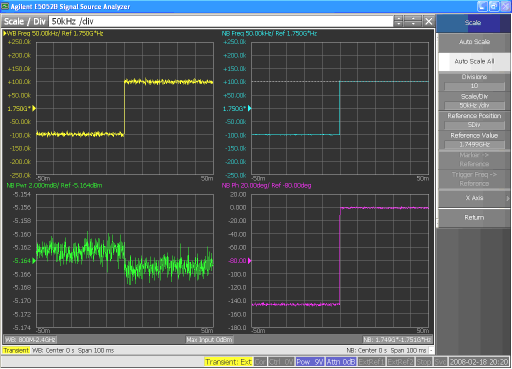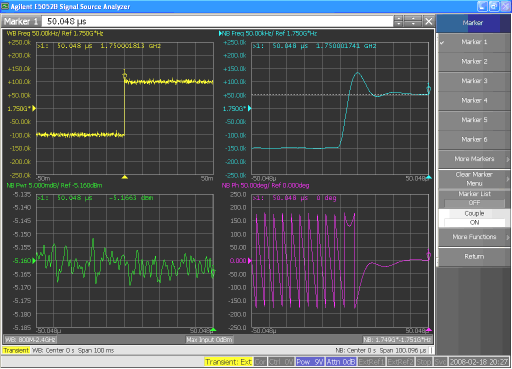
It assumes that this PLL synthesizer has an output signal for frequency change trigger. It can be used for the E5052B as a trigger source (external). Also, it is assumed that the delay of the output for frequency change trigger to the output from the synthesizer’s RF port is slight.
Press Meas/View > Transient to select the transient measurement window.
Press Window Max to maximize the window.
Press Setup > Wide Freq Range > 800 M – 2.4 GHz, then press Target requency > 1.75GHz and Freq Range > 1.6MHz.
Press Trigger > Trigger to Transient > Continuous to start measurements. Then press Source > External.
Change the output frequency of the PLL synthesizer from 1749.8 MHz to 1750.0 MHz.
Press Scale > Auto Scale All.
Confirm the display is updated when the output frequency is 1.75 GHz.

Press Trace Next key to select the WB Freq trace (upper-left trace), then press Start/Center > Wide Span > 100 ms.
Press Trace Next key to select the NB Freq trace (upper-right trace), then press Start/Center > Narrow Span > 100 us and Narrow Time Offset > 0 s. (Span Setting is changed to 100.096 us)
Change the output frequency of the PLL synthesizer to 1749.8 MHz, then change to 1750.0 MHz.
Press Scale > Auto Scale All. Confirm the NB Freq trace (frequency transient).
Press Trace Next key to select the NB Freq trace (upper-right trace), then press Marker and move Marker 1 to the right end of the frequency trace.
Press Couple to turn couple maker ON.
Press Marker -> > Marker -> Target Freq > Marker -> Phase Reference, then change the output frequency of the PLL synthesizer to 1749.8 MHz, then to 1750.0 MHz again. Phase trace is calculated from the phase reference frequency on the frequency trace.
Confirm that the phase is going to stable (nearly 0 degree) on the NB phase trace.

For more information about Transient Measurement, See Transient Measurement.